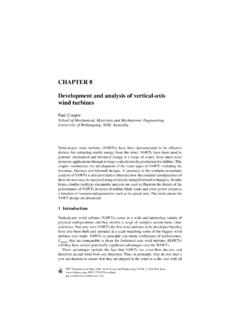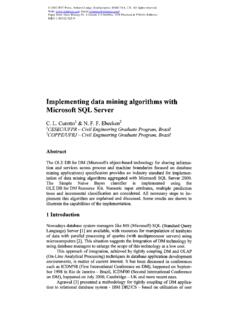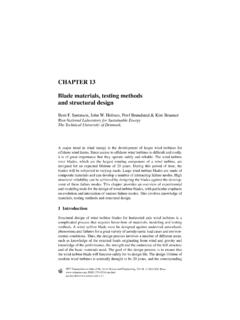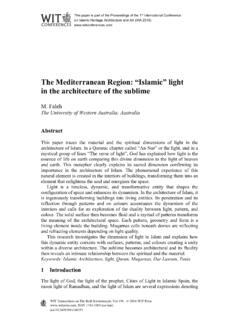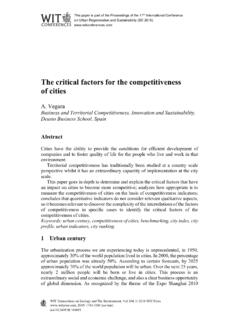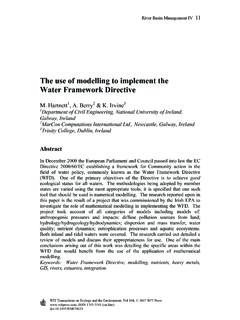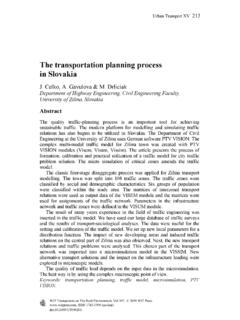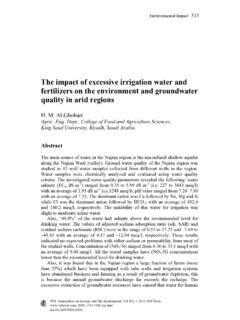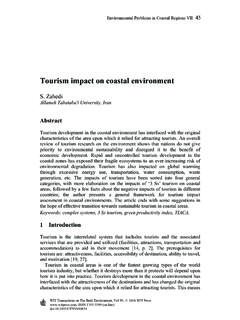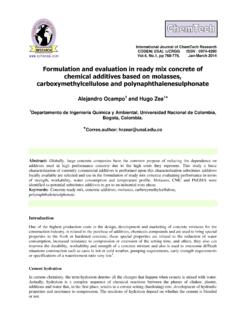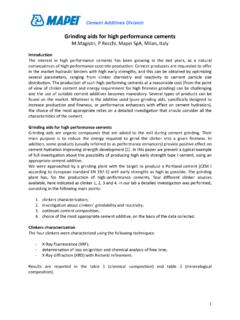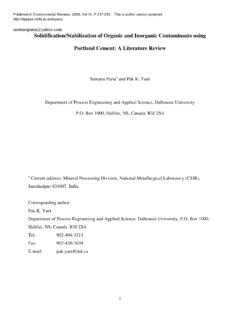Transcription of MICROSTRUCTURAL STUDY ON THE EFFECTIVENESS OF COMMERCIAL ...
1 N. Mohamed Sutan, et al., Int. J. Comp. Meth. and Exp. Meas., Vol. 2, No. 3 (2014) 269 279 2014 WIT Press, : 2046-0546 (paper format), ISSN: 2046-0554 (online), : STUDY ON THE EFFECTIVENESS OF COMMERCIAL POLYMER EMULSION AS cement additives TO MITIGATE EFFLORESCENCEN. MOHAMED SUTAN1, I. YAKUB1, S. HAMDAN1 & Z. A. TALIB21 Department of Civil Engineering, Chemical Engineering and Energy Sustainability, Mechanical Engineering, Faculty of Engineering, Universiti Malaysia Sarawak, Sarawak, Malaysia. 2 Department of Physics, Faculty of Science, Universiti Putra Malaysia, Selangor, occurrence of calcium carbonate (CaCO3) effl orescence phenomenon is not new and is generally found in the form of unsightly white deposits on the surface of cement products.
2 It appears just after completion of building construction and causes aesthetically unpleasant sight. This paper presents and discusses the results of MICROSTRUCTURAL STUDY on the EFFECTIVENESS of COMMERCIAL polymer emul-sion as cement additives to mitigate effl orescence on cement -based products that are dry-cured in the concrete laboratory at daily room temperature (T) and relative humidity in the range of 18 C 28 C and 65% 90%, respectively. Polymers used as cement additives were styrene acrylic ester (SAE) and styrene butadiene rubber (SBR) emulsion.
3 Due to their pore-blocking characteristics and interaction with cement to improve mortar quality, they are added into cement to form mortar used for repair purposes. In order to investigate on how they can microstructurally infl uence effl orescence forma-tion, effl orescence intensities (EI) in terms of percentages of CaCO3 resulting from the combination of puddle test and standard chemical method were compared systematically between all samples on 28, 60 and 90 days and the fi ndings were discussed and corroborated physicochemically using initial surface absorption test, X-ray diffraction (XRD), thermogravimetric analysis (TGA)
4 And morphology using scanning electron microscopy (SEM). Results indicated that 10% and 5% SAE addition signifi cantly reduced primary effl orescence and secondary effl orescence, respectively, in comparison to SBR and Control. The infl uence were on chemical reactivity, interaction between polymer and cement and on the movement of the polymer particles within the hydrating mortar as hydration progressed to form pore-blocking effects in the microstructures of cement -based materials and were refl ected in the XRD patterns, TGA/DTG analysis, SEM images and the decreased initial surface water.
5 Effl orescence, polymer, XRD, TGA/DTG, SEM, INTRODUCTIONM odern concrete can be made into a variety of fi nishes and colours offering architects and the construction industry a material that is both practical and aesthetically pleasing [1]. The cur-rently available inorganic colour pigments, for example iron oxide pigments, are lightfast (colour unaffected if exposed to light) and weather stable. Therefore, the strong colour they impart to concrete could last for decades [2]. Unfortunately, colour changes of concrete can arise due to a well-known yet not well-understood phenomenon called effl orescence [3 6].
6 White effl orescence salts, while not necessarily increased by concrete pigmentation, are more visually apparent when concrete is coloured than when used in its natural grey form. In addition, coloured concrete tends to be fi nished to a higher standard for aesthetic purposes. Therefore, effl orescence is particularly noticeable in these circumstances. Effl orescence, which used to be ignored due to its negligible structural effect, is now viewed as a major problem in coloured concrete products [3, 7].
7 It could also be an issue of the EFFECTIVENESS of the adhesion of the protective coating of fa ade [8]. To date, there are no economical and effective methods to guarantee the prevention of effl orescence [9 11]. ACI 116R-90 defi nes effl orescence as a deposit of salts, usually white, formed on a surface of concrete or masonry, 270 N. Mohamed Sutan, et al., Int. J. Comp. Meth. and Exp. Meas., Vol. 2, No. 3 (2014)the substance having emerged in solution and subsequently been precipitated by evaporation. There are different generic types of effl orescence that can be identifi ed chemically by the different types of salts, visually by the type of material on which they occurred and sensually by their textures [12, 13].
8 Even though effl orescence is classifi ed as non-degradation durability which is aestheti-cally unpleasant, some of the worst cases of effl orescence do affect the durability of concrete and reduce the strength due to deterioration. The most signifi cant factors that contribute to effl orescence are the permeation characteristic of the surface near the concrete [10, 14] because in such cases concrete is used for aesthetic functions. Surface appearance of concrete has been as important as its strength. Figure 1(a) shows the effl orescence formation on con-crete structure in a building in Malaysia after a few months of completion.
9 This exasperating view can disturb the motive of this decorative architectural concrete structure. Another effl o-rescence formation shown in Fig. 1(b) is at the staircase of the building. It was observed that the effl orescence at concrete surface also contributes to spalling of concrete orescence may be primary or secondary as schematically shown in Fig. 2. It is a deposit of crystallized calcium carbonate (CaCO3) or calcite on the exposed concrete and cementi-tious materials manifesting from hazy white layers to thick white crusts [10].
10 This manifestation is caused primarily by the leaching out of calcium hydroxide (CH) with min-eral called Portlandite, one of the hydration products of Portland cement , which is slightly soluble in water, migrating to the concrete surface through the capillary system of the con-crete and evaporated to leave the solid CH, which then reacts with atmospheric carbon dioxide (CO2) to form CaCO3 [3 6, 11]. CH crystals represent 20% to 25% of volume of solids in hydrated ordinary Portland cement (OPC) paste [15, 16].
